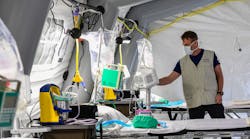About a 40-minute drive to the east of China’s capital, Beijing Aeonmed Co. has been working around the clock since Jan. 20.
After meeting the country’s needs two weeks ago, its factory lines have been working flat out on orders from overseas for its lifesaving ventilators. With three shifts and even research and development staff on the production line, the company’s machines have been going non-stop.
“There’s literally no country in the world that doesn’t want to buy a ventilator from China right now.” said Li Kai, director of Beijing Aeonmed, “We have tens of thousands of orders waiting. The issue is how fast we can make them.”
As the global coronavirus death toll inches toward 15,000, doctors from Milan to New York are desperately seeking ventilators. In severe cases, the availability of a ventilator that can help a Covid-19 patient breathe can determine if he lives or dies. Late last week, New York Governor Andrew Cuomo said the state, which has about 5,000 to 6,000 ventilators, might need 30,000 of them.
“It’s ventilators, ventilators, ventilators,” Cuomo told reporters. “That is the greatest need.” The state “has people in China shopping for ventilators,” he said.
Overall in the U.S., the Society of Critical Care Medicine estimates that 960,000 patients would need ventilator support due to Covid-19, but the nation only has about 200,000 such machines. In Italy, the country with the most number of fatalities from the pandemic, a severe ventilator shortage has forced doctors to triage patients.
The mad scramble for scarce medical supplies comes as China and the U.S. try to deflect blame for their handling of the disease. China has been seeking to claw back an international leadership role after early cover-ups helped the virus spread well beyond its borders. The country has sought to brand itself as Europe’s savior in the fight against the pathogen, providing masks and other supplies to the region’s virus hot spots.
For companies like Beijing Aeonmed, though, it’s roaring business as orders pour in from dozens of countries, many of which are chartering planes or using military aircraft to pick up the machines. Aeonmed isn’t the only Chinese company racing against the clock to build ventilators.
“All the ventilator factories in China have reached their maximum capacity, occupied fully by foreign demand,” said Wu Chuanpu, director of supply chain at Vedeng.com, one of the main platforms in China connecting medical equipment suppliers and buyers.
The factories have orders to keep them at full capacity until May, according to Wu. Vedeng is still getting more than 60 to 70 new orders every day, each asking for hundreds or thousands of such machines, he said. Many are from governments.
Ventilators pump oxygen into the lungs and remove carbon dioxide from the body. Many patients inflicted by the coronavirus need the machine because their blood oxygen level drops precipitously -- a condition called hypoxemia -- which can cause organ damage and be potentially life threatening.
The ventilator demand is so great that U.S. President Donald Trump has given automakers the green light to reconfigure their plants to make the machines.
Ford Motor Co., General Motors Co. and Tesla Inc. have been given the “go ahead” to make ventilators, Trump said in a tweet Sunday.
However, unlike face masks or thermometers, where companies can quickly ramp up production, ventilators have a higher barrier to entry, making a rapid expansion of production more difficult, Wu said.
“The expansion of the production line is very time-consuming and resources-intensive,” he said. “It also involves personnel training. It is too cumbersome.”
The dramatic increase in demand for the machines is in stark contrast to their need in normal times. Ordinarily, hospitals have a few dozen machines that are required for only critical cases. Now, it may need them for every bed in its intensive care unit.
China’s Ministry of Industry and Information Technology said earlier this month that as of March 3, the country’s main manufacturers delivered about 14,000 non-invasive ventilators and 2,900 invasive ones to Hubei, the region where the coronavirus outbreak originated. That compares with the nationwide demand for ventilators in 2018 of 14,700, according to Huajing Research.
Meanwhile, as the orders come in, Beijing Aeonmed expects to ring in sales that are several times more than last year.
“The epidemic is not a problem of just one country,” said Li. “The global fight against the pandemic is a test of made-in-China speed and quality.”
By Jinshan Hong and Dong Lyu




